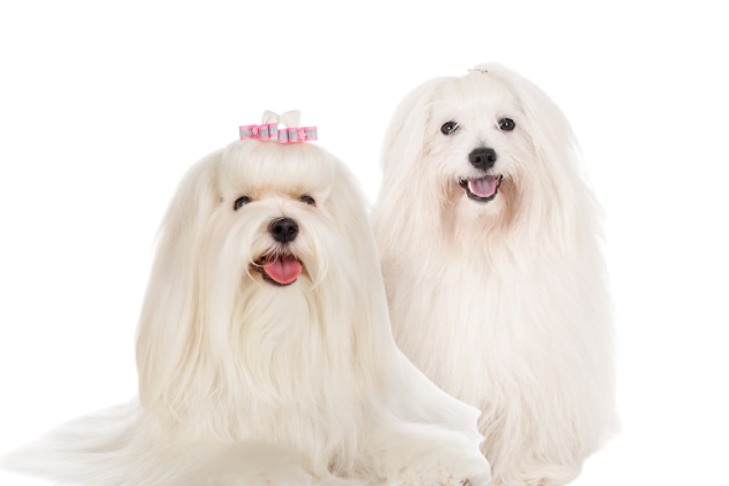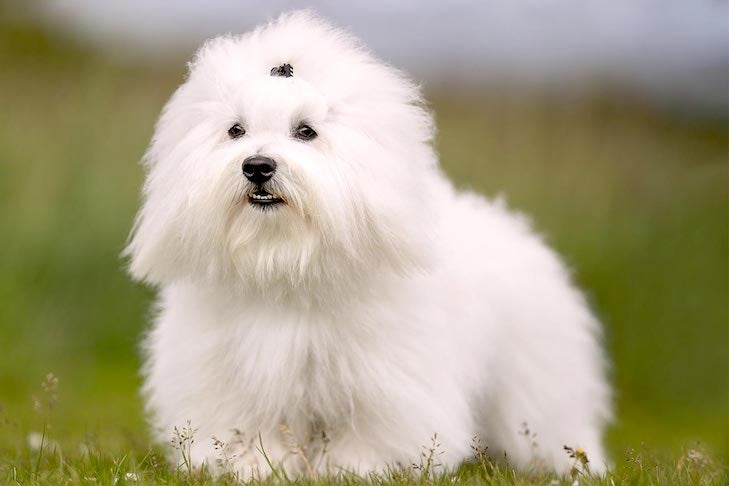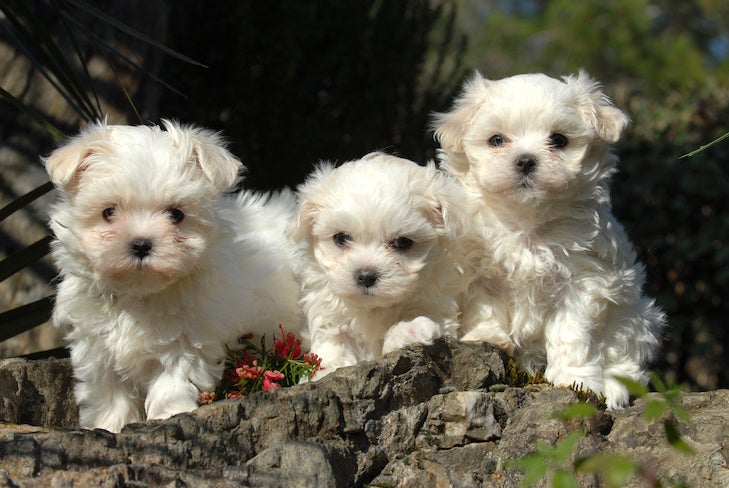
When you see a little dog with a long white coat sweeping down the sidewalk, do you know which breed you’re about to meet? Is it the playful Maltese or the happy-go-lucky Coton de Tulear (pronounced KO-Tone Dih TOO-Lay-ARE)? Both breeds are adorable and charming, but their history and personality are different. Read on to learn more about these two adaptable dogs and how to tell them apart.
Long White Coats
As stated in the Maltese breed standard and the Coton de Tulear breed standard, both dogs are white with black noses, eye rims, and toe pads. But they differ in size. Male Cotons de Tulear can weigh nine to 15 pounds and stand 10-11 inches high at the shoulder, whereas Maltese are under seven pounds and only seven to nine inches tall. Plus, the Maltese is a member of the Toy Group and the Coton a member of the Non-Sporting Group.
According to Eileen Boyer Narieka, Coton owner for 22 years, breeder, educator, judge, and current vice president of the United States of America Coton de Tulear Club, the main similarity between the breeds is both are companion dogs with long white coats. However, Narieka states “The two breeds are very distinctive in their appearance. A Coton has a unique, soft cotton-like coat, is larger in size, and has a definite rectangular silhouette.”
Tammy Simon, who has been breeding and showing Maltese for over 34 years and currently serves on the board of the American Maltese Association, agrees that there are many differences between the breeds including their coats. “The Maltese has a white silk coat that grows long and hangs flat against the dog. Their hair can grow all the way to the floor, but the Coton’s remains much shorter. Also, the Maltese head hair is generally tied up with topknots and bows, whereas the Coton’s is left loose on the head.”
- Coton de Tulear
Happy Personalities
Adaptable Cotons fit any lifestyle and will adjust their energy levels and daily schedules to suit their owner’s pace. They thrive on their owner’s attention yet can entertain themselves, being content to simply be near their humans. Cotons are happy and even-tempered, pleased to sit on your lap or go for a long walk, hike, or swim. These sturdy and versatile dogs also enjoy dog sports and excel at agility.
Narieka describes them as a big dog in a little dog’s body. “He is highly intelligent, trainable, and loves to interact with his owners who find him to be very charismatic, rather clownlike, and delightfully entertaining as he stands on his hind legs, dancing and twirling with joy. Cotons possess rather unique vocalizations and make soft, engaging sounds that seem to be telling you a story. This is often accompanied by the endearing ‘Coton head tilt’ that is sure to make you smile.”
The lively Maltese is fearless and, if not exposed to proper puppy socialization, somewhat protective of their humans. As they were bred to be companions, they are true lap dogs and fully focused on their people. These traits serve them well as therapy dogs or medical service dogs such as diabetic alert dogs or seizure response dogs.
Simon refers to the Maltese as syrupy sweet and believes you will never feel as much love from any other breed. She says once somebody gets a Maltese, they always come back for another. “Maltese are very active, playful, and happy. They are usually content with sitting on someone’s lap and following you around the house with daily activities. They can be little shadows. They also love to go on walks and just be with their humans and usually get along very well with other animals in the home.”
- Ch. Aennchen’s Shikar Dancer, Maltese.
- Coton de Tulear, first Westminster winner of the breed
Ancient History
Cotons are relatively new to the dog world, first arriving in America in 1974; however, their origins can be traced back over 500 years. The ancestors of these Royal Dogs of Madagascar were members of the Bichon family of dogs who accompanied sailors on sea voyages. According to Narieka, “There is a common story that during a violent storm, a shipwreck occurred in the proximity of Tulear, Madagascar. Some of the little white dogs from this ship swam ashore near Tulear, and it is assumed that they are the ancestors of the Coton de Tulear. Their cotton-like coats provided insulation from the diverse hot and cold climates of this exotic island where they survived in the wild and developed into the breed we know today.”
The Maltese has an even older history. Originating on the island of Malta in the Mediterranean Sea, the American Kennel Club registered the first Maltese in 1888, but they have been around since 1500 BCE. Simon says, “They are recognized as ‘ye ancient dog of Malta,’ and were bred primarily as companion dogs with roles as status symbols and fashion statements for Aristocrats. At one point in history, it was believed they had the power to heal.”
- Maltese puppies
Wonderful Companions
The Coton will alert bark, but the breed is not known for excessive barking. Narieka believes living with one is an absolute joy. “Cotons de Tulear develop a remarkable sympathetic awareness and a compassionate bond with their owners. They’re gentle beings whose soulful gaze comforts you and melts your heart.”
The Maltese requires regular grooming and thrives in a home environment with all kinds of families. However, Simon cautions that young children are not always the best match for small puppies and socialization is essential for creating the best family pet. She praises the Maltese for their healing powers. “Maltese will always make you smile, lower your blood pressure, and give you a sense of contentment and happiness.”
Either of these amazing dogs would make a terrific pet in the right home. And now that you know the difference, the next time you encounter a small white dog with a flowing coat, you’ll know which incredible breed you’re greeting.







